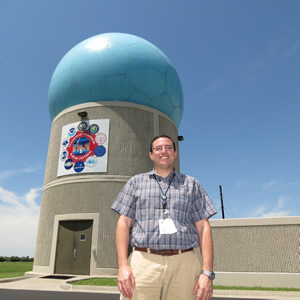
Phased array radar (PAR) technology will help forecasters of the future provide earlier warnings for tornadoes and other types of severe and hazardous weather. We are currently adapting the SPY-1 radar technology, which was developed by Lockheed Martin to support tactical operations aboard Navy ships, to weather detection.
The primary advantages of PAR for radar meteorology are:
Here is an interesting news article on PAR technology for weather observations published in the IEEE Spectrum Magazine in June of 2011.
For more information about the PAR projects that I'm currently working on, click on the following links:
Also, check out the official NSSL webpages on PAR research and on the MPARSUP project.
We recently received a second award from the National Science Foundation (NSF) for our research project "Understanding the Relationship Between Tornadoes and Debris Through Observed and Simulated Radar Data."
This fall, I had the honor and privilege to teach an OLLI class with my friend and colleague Jami Boettcher. "NEXRAD Weather Radar: How it Works and What Those Images Tell Us" kept us busy for 5 weeks this fall.
Our paper "Bootstrap Dual-Polarimetric Spectral Density Estimator" made the cover of the April 2017 issue of the IEEE Transactions on Geoscience and Remote Sensing journal.
I have accepted to serve as an associate editor for the American Meteorological Society’s Journal of Atmospheric and Oceanic Technology.
I have been chosen as the winner of the 2016 OU College of Atmospheric and Geographic Sciences Dean’s Award for Outstanding Service.